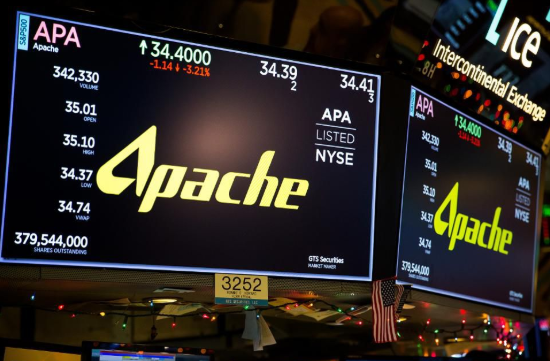
A monitor displays Apache Corp. signage on the floor of the New York Stock Exchange (NYSE) in New York on Friday, Nov. 30, 2018. Apache is an oil and gas company that has consistently generated positive cash flow in recent years. Photographer: Michael Nagle/Bloomberg © 2018 BLOOMBERG FINANCE LP
One of the refrains I often hear about the oil industry -- particularly on those focused on shale and tight oil -- is that it collectively doesn't make any money. There have been many stories over the past few years about the ongoing negative free cash flow (FCF) problem among the shale producers.
It is true that in recent years oil companies have collectively outspent their revenues. But two important issues are often overlooked in the stories about negative cash flow.
First is the question of the reason cash flow is negative. To better understand this, let's talk about what cash flow actually represents.
FCF measures cash generated by a company in excess of its spending, including capital expenditures. There are some differences between how different analysts measure FCF, but I use the levered FCF definition from the S&P Global Market Intelligence database.
This number is calculated by starting from net income, adding back depreciation and amortization (because those non-cash costs relate to historical expenditures), adjusting for impairments to oil and gas properties (those non-cash impairments are applied against net income but not cash flow) and then subtracting interest paid, changes in working capital and capex.
This is a more accurate and comprehensive definition of cash flow than the one used by many, which is simply cash generated from operations minus capital expenditures.
It is true that capital expenditures are the main reason that FCF went deeply negative for so many companies in recent years. When oil prices were $100 a barrel, oil companies invested every penny they could get their hands on into producing more oil. There were no guarantees of how long the high prices would last, but it's understandable why they were plowing all their cash back into their business.
When oil prices plunged in 2014, many companies were caught off guard. Some were extremely leveraged and went bankrupt. All of them had to slash spending. And that leads to the second point that is frequently overlooked.
Oil companies aren't all operated in the same way. Some operate recklessly and with excessive leverage, while others are much more conservative. That is reflected in the individual results of these companies.
Some companies go for years without generating positive FCF. Diamondback Energy, for example is one of the largest pure shale/tight oil producers. They went public in 2012, and have never generated positive FCF. But that hasn't posed a problem, as their debt/EBITDA ratio is at a manageable 2.5.
Further, Diamondback shares have risen by 470% since the company's 2012 initial public offering -- nearly five times the return of the S&P 500. Thus, despite years of negative FCF, Diamondback's stock market performance leaves most of its peers in the dust.
Also consider Anadarko, which Chevron and Occidental are aggressively competing to acquire. In the past ten years, they have only generated FCF three times. But the company is viewed as an extremely attractive asset.
Then there's ConocoPhillips, which is active in the Eagle Ford, Bakken and Permian Basin. In recent years, COP has been the king of cash flow among the pure oil and gas producers.
In the past ten years, ConocoPhillips has generated positive FCF seven times. They took a hit like most other producers in 2015, but the company responded with significant belt-tightening. The firm slashed its dividend, cut capital spending, and sold a number of assets. The result has been a steady improvement in the company's cash flow.
In 2017 and 2018, ConocoPhillips generated $7.3 billion and $6.3 billion of FCF, respectively. The number fell in 2018 due to the divestment of assets. To put these numbers in perspective, only one other publicly traded oil and gas producer -- Canadian Natural Resources -- recorded more than $1 billion of FCF in either of those years.
Among the ten largest oil and gas producers half have pretty consistently generated positive FCF since coming out of the 2014-2015 downturn. Joining ConocoPhillips in this group are EOG Resources, Canadian Natural Resources, Continental Resources, and Apache.
I would add that all of the integrated supermajors have generated positive FCF over the past two years. Royal Dutch Shell generated a whopping $21.1 billion in FCF in 2018 after generating $10 billion in 2017. In total, the five supermajors generated $66 billion of FCF in 2018.
To put it all in perspective, there are still a number of oil companies that are outspending their revenues. But, there are also many companies that are consistently in the black, and the overall industry has made huge strides in recent years.
Consider that in 2013, and with oil prices at $100 a barrel, the Top 20 oil and gas companies produced negative $10.9 billion in FCF. In 2014, that deficit ballooned to $-33.3 billion, but it has improved each year since. In 2018, and with an average West Texas Intermediate price that was $35 a barrel less than in 2013 -- those same companies generated $384 million in FCF. Thus, in the past four years these companies have shown an improvement in FCF of nearly $34 billion.
As I explain to people, it's not that the oil industry can't generate positive FCF. It certainly can. But many companies choose to aggressively reinvest in their business, at the expense of FCF. That philosophy has waned since the 2014 downturn, but it remains to be seen whether producers can maintain spending discipline as oil prices rise.